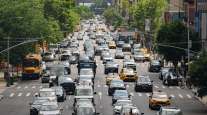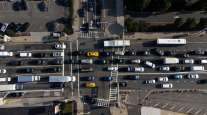Congestion Adds $63.4 Billion Burden to Trucking Industry, ATRI Reports

This story appears in the May 22 print edition of Transport Topics.
Traffic congestion added $63.4 billion in operational costs to the trucking industry in 2015, according to a new American Transportation Research Institute report.
Included is driver downtime and the cost of goods not being delivered or arriving late. Poor infrastructure and extreme weather also contributed to clogged American roads, as did a substantial increase in traffic accidents and GDP growth, ATRI’s “Cost of Congestion to the Trucking Industry: 2017 Update” found.
The overall figure marked an increase from 2014, when congestion added nearly $50 billion in operational costs.
The report, released May 16, placed Florida and Texas at the top of list of most congested states — both recorded more than $5 billion in costs and combined for 16.5% of the U.S. congestion price tag. Following them in the top 10 were California, New York, New Jersey, Illinois, Pennsylvania, Ohio, Tennessee and North Carolina.
The report relies on data from the Federal Highway Administration’s National Performance Management Research Data Set, FHWA’s Freight Analysis Framework, commercial truck GPS data from ATRI’s Freight Performance Measure database and industry financial data from ATRI’s “An Analysis of the Operational Costs of Trucking.” The analysis included the entire U.S. national highway system; last year’s analysis of 2014 data focused exclusively on interstate highways.
In 2015, about 90% of congestion costs were identified on 17% of the national highway system, predominantly in metropolitan areas. Metro areas of New York, New Jersey and Pennsylvania topped the list with nearly $4.6 billion. Miami-Fort Lauderdale-West Palm Beach, Fla., absorbed more than $2 billion in costs in 2015, rising 56.9% over the previous year.
Among counties, New York County has the highest cost at $112.4 million.
Although some states fared well, they still face challenges. For example, while Missouri shows a dramatic decrease in congestion expenses — 27.1% versus year-ago levels — Missouri Trucking Association President Tom Crawford pointed out that appearances aren’t always what they seem.
“Our congestion is going up,” Crawford said, “and we have had pretty substantial increases in congestion. It’s gotten noticeably worse because we haven’t done anything to alleviate it.” He noted, though, that the state has become better at mitigating accidents through a combined effort with its department of transportation and law enforcement.
While Minnesota finished about midpack in the report, Minnesota Trucking Association President John Hausladen is far from bullish. He noted that just about every shipment leaving the state must cross through the Twin Cities, making that the state’s major choke point for freight movement.
“Congestion continues to be a major challenge for truck drivers in Minnesota, and the key bottlenecks identified by earlier ATRI studies continue to be the major interchanges in the urban areas where everything really slows down,” Hausladen told Transport Topics.
Texas Trucking Association CEO John Esparza wasn’t surprised that the Lone Star State rated poorly. He attributes some congestion to an energy boom that began about four years ago, when natural gas and oil drilling surged.
“County roads took a pounding,” Esparza said, “and they weren’t designed for 80,000-pound trucks driving through town.” Those roads all connect to the metropolises and therefore affect the entire highway system, he noted.
He said the Texas Legislature overwhelmingly voted to earmark $4 billion for its roads and bridges, but that is dovetailing with a population boom. “Texas is growing by anywhere from 1,000 to 1,500 people a day,” he said.
ATRI President Rebecca Brewster told TT that roadway projects are a big factor that adds to congestion, but so is an improving economy because “there are just more trucks on the road.”
One likely contributor to that is the growth of e-commerce, and ATRI is watching how the rising importance of that sector will affect roads, she said.
“We don’t have any data just on the cost of that yet,” Brewster said, “but one of ATRI’s top research priorities is looking at e-commerce impacts on the trucking industry. What are the infrastructure impacts? What does it mean for drivers and their average length of haul?”
ATRI’s 2015 figures show growth in e-commerce sales of 14.6% over 2014.
Brewster added, “When you see figures like $63.4 billion in lost productivity to the industry, there is simply no way trucking alone can absorb that, and it starts to play out across the supply chain — as it costs more to ship, motor carriers make up for lost productivity, goods’ prices increase and the cost of transportation goes up.”
In a statement provided to TT, FedEx said, “Increased congestion, along with the lack of infrastructure investment, demands action by policymakers to modernize our transportation system.”
FedEx ranks second on the Transport Topics Top 100 list of the largest for-hire carriers in the United States and Canada.



